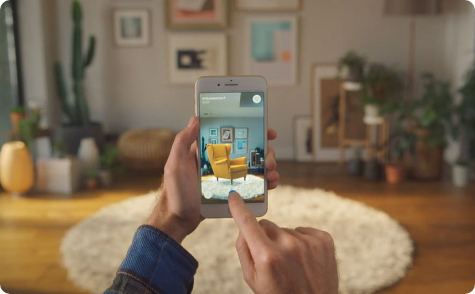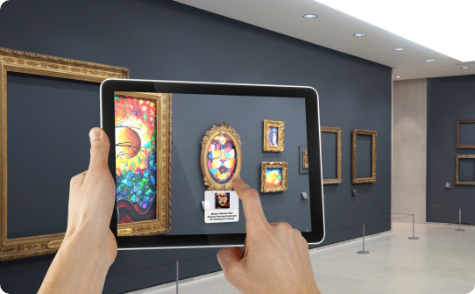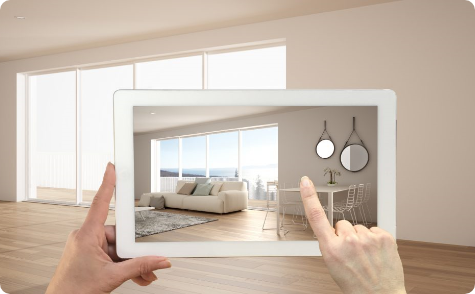What is augmented reality?
Augmented Reality (AR from Augmented Reality) is a reality enriched with information, objects and “artificial” data, added – thanks to particular digital tools – to the normal reality perceived by our senses. Augmented Reality enhances reality and allows the user a unique and fascinating experience at the same time. Imagine wearing a product, living in a bygone era, actually seeing an object that we like placed in the home: this creates desire and guides our shopping experiences.
Created for video games, Augmented Reality now has increasingly performing applications, based mainly on mobile devices (smartphones and tablets). It is increasingly loved by consumers, used in B2B, B2C and marketing strategies in various sectors: architecture, design, industry, beauty, fashion, tourism.
It should not be confused with Virtual Reality (VR from Virtual Reality), which is instead the digital simulation of reality and the need for an accurate graphic reconstruction, and sensors – such as viewers, headsets, headsets – that project sensations and emotions in an exclusive virtual world.
How does augmented reality work?
It can be activated in various ways but the main ones are two:
- Augmented Reality from smartphones and / or tablets, certainly the most widespread and known form. Using the sensors of the smartphone (gyroscope, GPS, accelerometer and camera) with Augmented Reality (AR) on the display you can see the environment in which the user is, enriched with all the additional information not present in the real world.
- Augmented Reality through glasses, which can be experienced primarily through Microsoft’s HoloLens 2. In this release, HoloLens 2 combines a wireless device with apps and solutions that help you learn, communicate and collaborate effectively.
Augmented Reality with Kjosul
Kjosul is already ready for augmented reality. How? With our digitization system, the objects prepared for the Kjosul 3D configurator are immediately usable also for the development of Augmented Reality with only the expansion of the programming part with a saving of time and money for the customer.
What are the application areas of Kjosul’s augmented reality?
Augmented reality is already exploited in various sectors, especially in the commercial field for the production of innovative services to support sales: just think of the famous IKEA App that allows customers to view the furniture inside their home.
It is a very versatile technology that does not solve a specific or particular problem but that becomes a tool with a great enabling power. For example, the medical, industrial, sports and retail sectors offer excellent examples of research and projects already carried out, which achieve increasingly positive and effective results.
Augmented reality in b2b
The main and most natural support that AR can give to companies is in the production and maintenance processes, providing additional information and data to workers, instructions to maintenance workers, etc. For example, in the field of Augmented Reality business, it is possible to frame a machine and see operating data around it, indications for maintenance, etc.

Augmented reality in marketing and e-commerce
The user is shown the product, simulating its presence in the environments where it could be placed or, in the case of accessories for the person, showing a virtual preview of what it would be like if worn. A practical example? Facebook and Instagram ads that allow you to see the new eyewear models of the most famous brands on your face.
According to recent research, around 40% of consumers would be willing to spend more on a product if the eCommerce they buy from offered an Augmented Reality experience. The interaction data on Facebook and Instagram ads (which are among the highest among the experiences offered by the platform) seem to confirm this trend.
Augmented Reality allows you to take a further step in the customer’s imagination: not only the objects are seen on the site but are seen projected into their home or onto themselves, increasing the desire for possession.
Art and tourist enjoyment of the territories
Augmented Reality is able to amplify artistic and museum experiences.
It is not for nothing that AR inside archaeological sites (Past View), museum collections and exhibitions are among the most requested because they are capable of identifying the observer by offering engaging experiences. In the museum environment, it allows you to create immersive itineraries for visitors, improving the experience provided by audio guides.


Architectural projects
Architectural design is one of the most exploited areas for AR.
What better way to involve and excite a customer than to show a project, not only in the two-dimensional surface of the sheet but in all its dimensions? Augmented Reality applied to 3D models shows every detail, different angles, and allows you to interact with a Real Time Rendering, also adding informative text boxes, images and videos.
Remote maintenance in industry 4.0
Large industrial plants, made up of more or less large components (compressors, turbines, gearboxes, etc.), often operate non-stop, and in places physically distant from each other.
Frequent maintenance of these systems, supported with a remote maintenance service and combined with modern Augmented Reality technologies, can be of considerable help and result in an increase in productivity and savings in financial resources.


